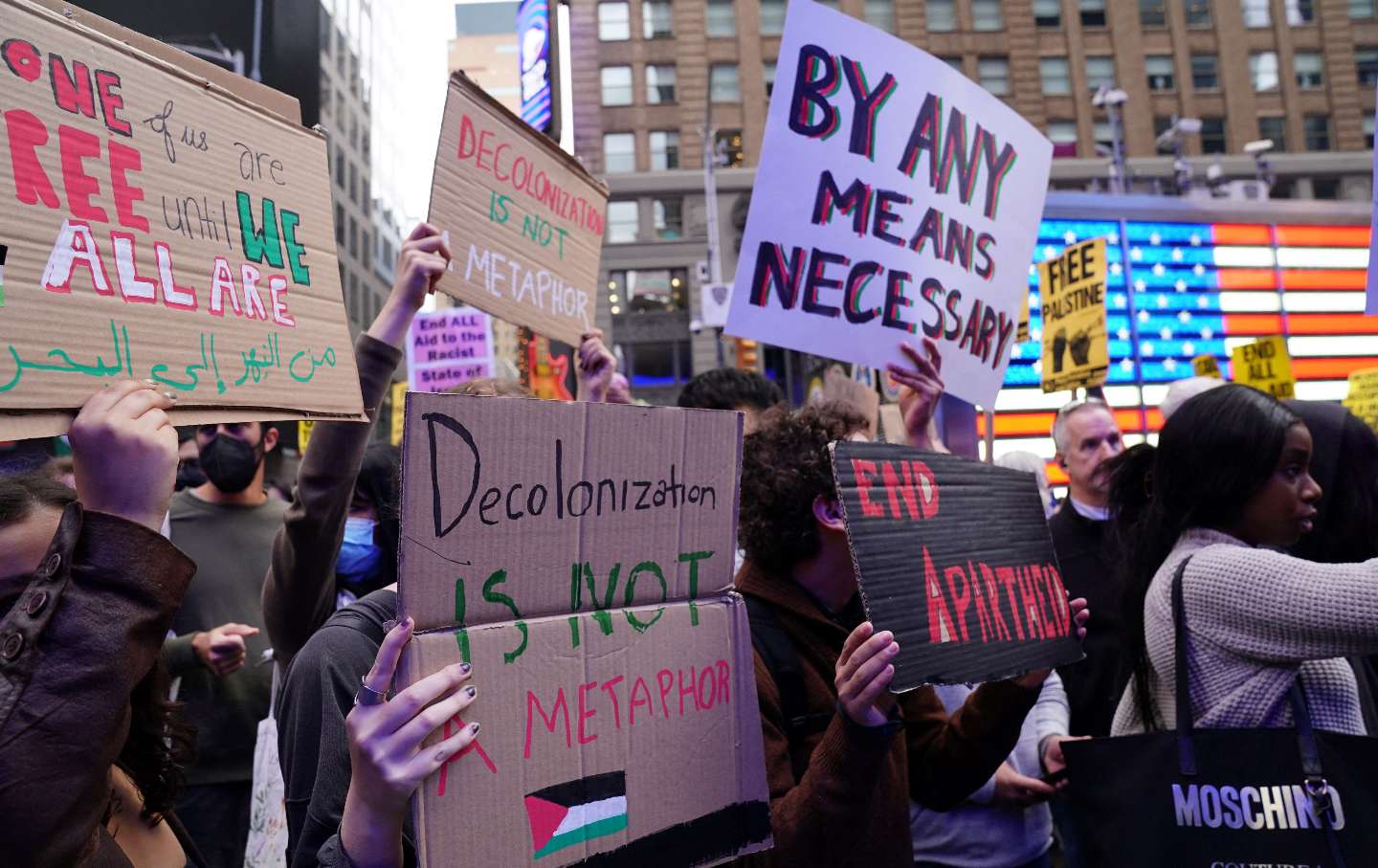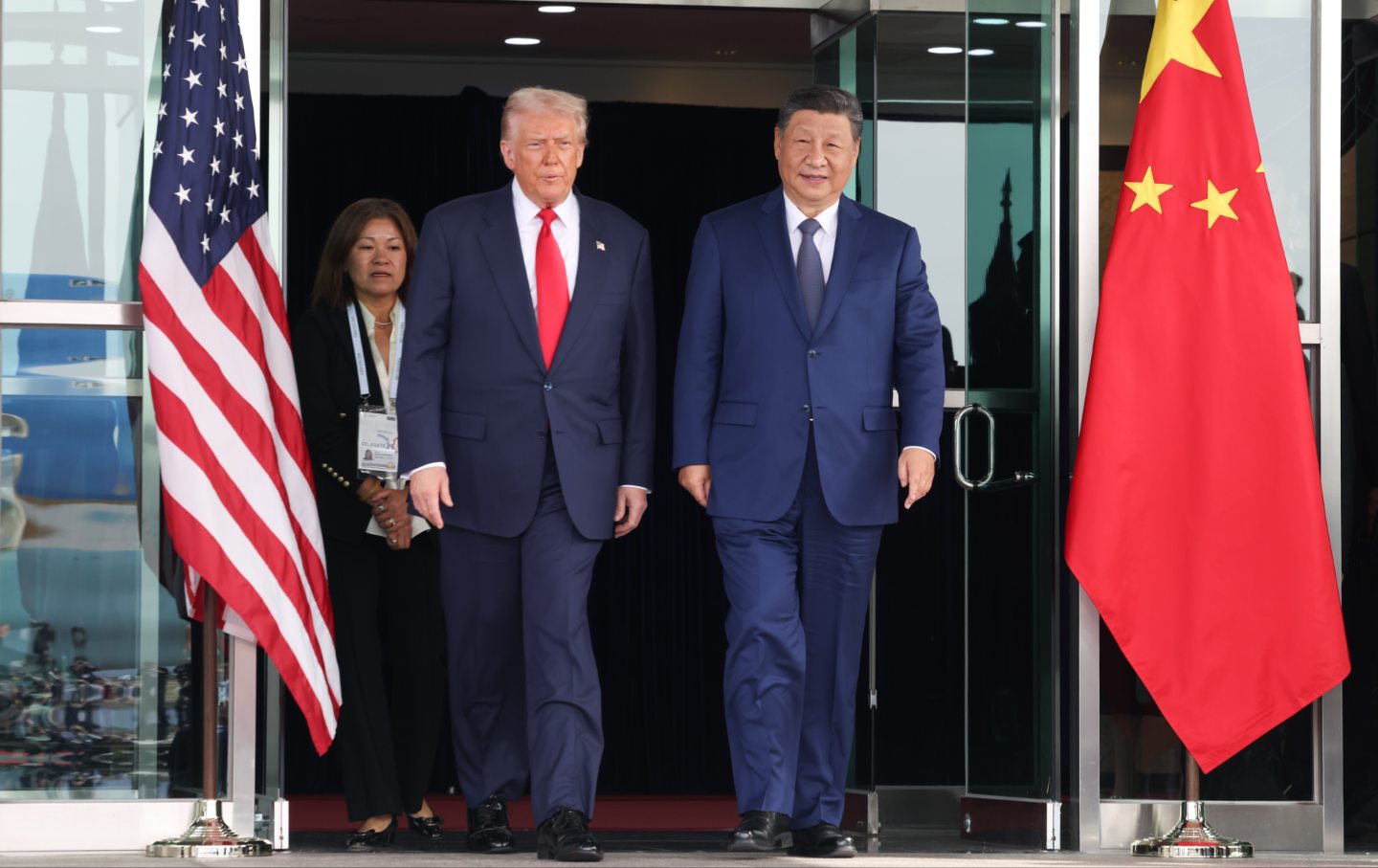After a Gaza Cease-Fire: D.D. Guttenplan
On this episode of Start Making Sense, The Nation’s editor comments on the future of Israel and Palestine, and Harold Meyerson analyzes the autoworkers’ victory.

Here's where to find podcasts from The Nation. Political talk without the boring parts, featuring the writers, activists and artists who shape the news, from a progressive perspective.
A cease-fire in Gaza is only the beginning of what Israel and the Palestinians need. D.D. Guttenplan, The Nation’s editor, argues that “both peoples will have to find a way to share the land—in peace, yes, but also with justice.”
Also on this episode of Start Making Sense: victory for the United Auto Workers in their strike against the big three automakers, GM, Ford, and Stellantis. Harold Meyerson, editor-at-large of The American Prospect, explains what’s in the new contract, and what it took to get there.
Our Sponsors:
* Check out Avocado Green Mattress: https://avocadogreenmattress.com
Advertising Inquiries: https://redcircle.com/brands
Privacy & Opt-Out: https://redcircle.com/privacy

People rally in support of Palestinians in Times Square in New York on October 8, 2023.
(Bryan R. Smith / AFP via Getty Images)A cease-fire in Gaza is only the beginning of what Israel and the Palestinians need. D.D. Guttenplan, The Nation’s editor, argues that “both peoples will have to find a way to share the land—in peace, yes, but also with justice.”
Also on this episode of Start Making Sense: victory for the United Auto Workers in their strike against the big three automakers, GM, Ford, and Stellantis. Harold Meyerson, editor-at-large of The American Prospect, explains what’s in the new contract, and what it took to get there.

Here's where to find podcasts from The Nation. Political talk without the boring parts, featuring the writers, activists and artists who shape the news, from a progressive perspective.
Ths coming Friday is the deadline for the Justice Department to turn over the Epstein files to Congress. But we already know the key fact about Epstein’s famous friends–they didn’t care that he had hired a 14-year-old girl for sex—and gone to jail for it. But why was that? Katha Pollitt comments.
Also: the hidden politics of the New York Times crossword puzzle: Natan Last explains; his new book is Across the Universe: the Past, Present, and Future of the Crossword Puzzle.
Our Sponsors:
* Check out Avocado Green Mattress: https://avocadogreenmattress.com
Advertising Inquiries: https://redcircle.com/brands
Privacy & Opt-Out: https://redcircle.com/privacy
Jon Wiener: From The Nation magazine, this is Start Making Sense. I’m Jon Wiener. later in the show, some good news in these dark times: victory for the auto workers in their strike against the Detroit big three. Harold Meyerson will report. But first, The Nation’s editor comments on Israelis and Palestinians. That’s coming up – in a minute.
[BREAK]
A Ceasefire in Gaza Is Just the First Step: for that, we turn to D.D. Guttenplan, he’s editor of The Nation, where you can find his editorial with that title. His books include American Radical: The Life and Times of I. F. Stone, also The Nation: A Biography, and he’s also producer of the documentary film, Edward Said: The Last Interview. You can see this documentary on YouTube. We reached him today at the magazine offices in Manhattan. Don, welcome back.
D.D. Guttenplan: Good to be back, Jon.
JW: We’re recording this on Tuesday, October 31st. Israel has killed at least 8,300 Palestinians in Gaza according to the Gaza Health Ministry. As of today, nearly 70% of those reported killed in Gaza are children and women, says the head of the UN Relief Agency for Palestine refugees. The UN humanitarian Office says more than 1.4 million people in Gaza have now been internally displaced. That’s more than half of Gaza’s population.
Meanwhile, in Israel, the toll from the Hamas attacks on October 7th has reached 1,300 dead. At least 3,300 wounded. 240 hostages are being held right now in Gaza according to the IDF. And today, of course, Israel’s invasion of Gaza is underway, which of course is killing lots more Palestinians and US Secretary of State, Anthony Blinken has restated the Biden administration’s position that now is not the time for a ceasefire.
You open your editorial for The Nation by declaring “condemning the slaughter should be the easy part.” But remind us what some people did instead of condemning the slaughter.
DDG: Okay, finger pointing is not my idea of my job. All I’ll say is that in the hours and immediate days after October 7th, some on the left seemed reluctant to even acknowledge, let alone denounce these murders. In other words, you would sometimes see statements by left groups deploring the loss of civilian life, but they would never mention the word ‘Hamas.’ You certainly saw statements, including by some student groups–and of course, with students, one has to make allowance for their youth, and perhaps, if I could be so patronizing, ignorance, in treating all of those children, women and elderly people slaughtered by Hamas as legitimate military targets.
Now there is a discussion that one could have about what we call terrorism and what we don’t call terrorism, but it seemed to me, and I say this as someone whose job is to take responsibility for every word The Nation publishes: while the blood was still wet in the south of Israel, it seemed particularly appalling to me to not allow for empathy and to not recognize that this was a catastrophe for Israeli citizens. Just as the murder from the air by the Israeli defense forces over the weeks since has been a catastrophe for Palestinians.
JW: You say “language matters.” You point to two statements made by Joe Biden: he condemned “the horrific horror of the attack by Hamas” and he also lamented the “tragic loss of Palestinian life” that followed. These statements are different in some crucial ways.
DDG: I put in my time as an English major, and they’re different because Biden, when it comes to killings by Israel, just like The New York Times and most of the mainstream media for decades, resorts to the passive voice as if these things just happen. Now, of course, it was my teacher, friend and mentor Edward Said, who first and most exhaustively pointed out that, when the question of Palestine is on the agenda, the passive voice is never far behind. But this was a particularly egregious example of it, and it appears to license and encourage the kind of slaughter that we’ve seen in the other direction over the last few weeks. And that is why we say a ceasefire is only the first step.
JW: Let’s go back a couple of years. Jared Kushner claimed to be bringing peace to the Mideast on behalf of Donald Trump with what he called the Abraham Accords. These were agreements with a few Arab states to recognize Israel and establish diplomatic ties. And part of the plan, really the basis of this plan, was to ignore the Palestinians. And what did Joe Biden do about that when he took office?
DDG: Well, that’s the thing. The Abraham Accords were a criminally stupid strategy. And the fact that Jared Kushner thought it was a bright idea is frankly no surprise to anyone who knows anything about Jared Kushner. But the fact that Biden embraced it and continued it was, to those who are easily shocked, shocking, and to those who are given to cynicism, ample cause for even more cynicism.
Remember the most recent installment of the Abraham Accords were meant to wed the US, Israel and the regime that Biden, when he was running for office and needed progressive votes, said he would treat as a pariah state, namely the Saudi Arabian regime that dismembered Jamal Khashoggi. Instead of treating them as a pariah state, he fist-bumped with MBS. And now he was trying to advance this separate piece whose only rationale strategically had to be to cut out the Palestinians. And whatever else you want to say, and I have no brief for it, don’t excuse it, consider it murder and a war crime: Hamas did also remind the world that you can’t cut out the Palestinians.
JW: Hamas is not a democratic socialist party. It’s led by reactionary theocrats who think Muslims should rule all of what is now Israel and expel the Jews. But how different is that from the corresponding view of Netanyahu’s ruling coalition?
DDG: Well, I say that no progressive would want to live under Hamas rule, but no progressive would want to live under Netanyahu’s rule either. Particularly since Netanyahu has gone some way to remove the various fig leaves that liberal Zionists like to put on the Israeli project over the last several decades. I mean, he’s caved in again and again, not just to his religious right, but to his fascist coalition partners. These were the people who were banned from politics under labor governments in the past, but who were clearly just as much a part of Israeli political and public life as Hamas is a Palestinian in public life, although they didn’t have control over the body politic the same way that Hamas has had control over Gaza–until relatively recently.
JW: I note that the chant in many of the pro-Palestinian demonstrations this past week has been “From the river to the sea, Palestine will be free.” But let us also note that the founding charter of Netanyahu’s Likud party declares “between the sea and the Jordan, there will be only Israeli sovereignty.”
DDG: Yes. Well, when The Nation’s London Bureau was marching with the Stop the War Coalition against the Iraq War and writing about it for The Nation in London 20 years ago, we noted that there was this chant and that it made it difficult for some of us to feel fully welcome in this march. So it’s not a chant for people who want to build broad coalitions. On the other hand, there are Palestinian friends of mine who argue that to see it as an eliminationist chant is to misconstrue it, that it simply reflects certain aspirations. Then I would say, ‘Well, you could say the same thing about Likud.’
I mean, in the end–and how you get to the end is one question, and how long you take to get to the end is another question. And how many bodies you pile up on the way to getting to the end is a third–and at this point, probably the most important question. But in the end, the two peoples are going to have to share the land. That is the only peaceful and just resolution. So to the extent that it signals that you are not willing to share the land with anybody, that is a counterproductive chant.
JW: That’s why you say that the ceasefire that we’ve been demanding is only the first step, and that it’s what comes next that’s the hard part. And you begin by saying, “We have to acknowledge some inconvenient truths.”
DDG: The first inconvenient truth is that those who make nonviolent resistance impossible make violence inevitable. And I’m talking here not just about the criminalization of dissent in Israel and in the West Bank, but also in the United States, where the only major nonviolent protest movement on behalf of Palestinian rights, the BDS movement, whatever you may think of its tactics or its conduct, has been banned from college campuses and outlawed by legislatures in 35 states. Well, whether you like it or not, to make it illegal is essentially to force people to embrace violence as their only avenue.
JW: But don’t you also think the advocates of BDS need to be clearer and more candid about their goals? Aren’t there some differences within BDS about this?
DDG: To me that’s the second inconvenient truth, which is that the advocates of BDS haven’t always been clear about whether their aim is: just to end Israel’s occupation of the territories that it conquered in 1967 and to gain full civil rights for Palestinians on either side of the green line, which are goals that all people of conscience should support. And in terms of the second of those goals, potentially attainable by various routes. Or whether the aim is to abolish the state of Israel altogether. Now, abolishing the state of Israel altogether seems to me a perfectly defensible aim if you’re a Palestinian, because nobody asked you, and suddenly, you’re having to share the land with people who mistreat you and subjugate you. On the other hand, if you are arguing that of all the ethno-states in all the world, the only one targeted for elimination is the Jewish one–that seems to me a reason for Jews to be suspicious and perhaps reluctant to engage in coalitions with you. And again, if there’s going to be progress on this, there are going to have to be larger and broader coalitions, not narrower and purer sects.
JW: The official US government position opposing a ceasefire is based on the argument that a ceasefire would only benefit Hamas at this point. I think that’s a quote from Blinken. What do you think about that?
DDG: That goes back to the question I talked about earlier, which is how many bodies you want to pile up on the way to resolving this? It’s certainly likely that if there were a ceasefire now, Hamas might restock or refuel or replenish supplies. On the other hand, the Israeli forces could get some sleep. But that’s not really the point. The point is that every dead civilian on either side that you add to the horrendous body count that has already accumulated, does absolutely nothing except make it more difficult to get to the path to peace. So since we all recognize there needs to be a ceasefire at some point, why not stop killing now?
JW: What are the tasks for the left in particular at this moment in the Mideast?
DDG: You know what? That was a hard one for me. What should the left focus on? And so I reached for a touchstone that I always reach for when I’m engaging with this question, and I’ll read what I found first and then I’ll tell you where it comes from. “To me, the values that the left needs to stress are that no human being should ever be threatened with transfer out of his or her home or land; that no human being should be discriminated against because he or she is not of an X or a Y religion; and that no human being should be stripped of his or her land, national identity or culture, no matter the cause.” That seems to me to be essential, the essential ground for any progressive movement on this issue. And those principles were set down in 1979 by Edward Said in The Question of Palestine. And they seem to me to be unimprovable upon and eminently worth fighting for, just as much, if not more, today than they were in 1979.
JW: ‘The path to peace and justice may seem impossible to detect right now, but there is, as the Israelis like to say, no alternative.’ That’s from Don Guttenplan in his editorial, “A Cease-Fire in Gaza Is Just the First Step.” It’s the lead editorial in the new magazine. You can read it at thenation.com. Don, thanks for talking with us today.
DDG: Thanks, Jon.
[BREAK]
Jon Wiener: Now, it’s time for what Naomi Klein calls “a beacon of light in these shadow-filled days” – victory for the United Auto Workers in their strike against the big three automakers, GM, Ford, and Stellantis. For that, we turn to Harold Meyerson. He’s editor at large of The American Prospect. We reached him today in our nation’s capital. Harold, welcome back.
Harold Meyerson: Always good to be here, Jon.
JW: This comes after 8,700 members of the United Auto Workers have been on strike for six weeks. It’s the longest US auto strike in 25 years. The union announced first on last Wednesday a tentative deal with Ford. Then with Stellantis on Saturday, they make Dodge Ram, Chrysler, and Jeep. And then on Monday morning, we got the news that the last of the big three, GM had also agreed to a tentative contract. The union started out asking for a 40% raise and several other big things. What’s in the deals that are now being voted on by union members?
HM: Well, a lot is in the details. And in some ways what you see in the details is the restoration of the historic UAW contract of 1950, which created some things that have vanished in recent decades but are now back–and in some ways that go beyond that. So let me run through the particulars. First, in general, there is a 25% raise over the four-year, eight-month duration of these contracts, but it’s really more than that because the UAW got the COLA, the cost-of-living adjustment reinstated after it dropped out of these contracts around about the time of the bank collapse and ensuing recession of 2008. And so when you factor that in for the average UAW member at these three companies, the raise, it really comes to about 30% and perhaps more, it depends on the rate of inflation. So it’s really about a 30% raise, but it’s not uniformly a 30% raise. In the spirit of solidarity, which not every union can accomplish, it is a much higher raise for the lower paid workers, for workers who were on a lower pay scale. And it also makes temp workers, permanent workers. As soon as the contracts are ratified by the rank and file, they shift that status. And if they’re a new temp hires, they become permanent after nine months. So for these lowest paid workers, the wage hike amounts to – I need a drum roll here – an 88% wage hike.
JW: Wow! Join a union, get an 88 percent pay hike.
HM: I think that is the most mind-boggling. And whoa, there are bonuses: There’s a $5,000 bonus to workers once the contract is ratified. There are increases to the company’s contributions to 401k’s, and then two other, I think, really significant things. The union will now – has a right, without violating the contract – it’s in the contract that it has a right to strike anytime there are future plant closures, that is kind of a victory of your defensive strategy. But there is a victory on the offensive strategy as well, which is that – we don’t have the details on all of this, but it appears that the deal that had been previously agreed to at General Motors about extending union membership to workers at the joint venture battery factories; some version of that is a feature of the Ford and probably the Stellantis contract as well. Also, some increases in pay to existing retirees. This is a victory for UAW members past, present, and future.
JW: I want to dwell for a minute on the history here. Going back to the 2007 financial crisis and the government bailout to prevent the bankruptcy of Chrysler and GM. Part of that deal forced UAW workers across the big three to give up their cost-of-living adjustment, to give up health insurance for retirees. Many of them were not old enough for Medicare. And most significant was the introduction at that point of this two-tiered pay system. At that point, new hires would start at half of what existing workers made, and not get a pension.
The result was really devastating. Since the crash in 2007, average hourly wages for workers in all vehicle manufacturing adjusted for inflation have fallen by nearly 20%. Meanwhile, the automakers have seen enormous financial success. Profits at the big three have almost doubled during this period. The companies have spent billions on stock buybacks. CEO pay has gone up by 40% in just the last couple of years. Mary Barra, the CEO of GM earned $29 million last year. Meanwhile, the UAW did nothing about this since 2007, 2008. Why not?
HM: If we look at the experience of the UAW now and the experience of the Teamsters now –because the Teamsters won a huge victory at United Parcel Service earlier this year, while threatening to strike–we kind of see a new generation of union leaders who, unlike virtually every other union leader, has been elected by the rank-and-file. And let us face it, the rank-and-file is comprised of your basic average Americans who tend to be rather off, A, the economy, and B, when they think about it, the economic inequality. I should add, and this is an important point, that the only reason that these two unions went to rank-and-file elections was corruption of the ancien regime leadership of both unions and the federal government’s intervention, which promoted rank-and-file elections rather than convention delegate elections, which generally had been fairly well manipulated both in these unions and honestly in a whole bunch of other unions which aren’t corrupt. But that system promotes sort of maintenance of leadership, which is something leadership is generally concerned about.
JW: In 2017, the feds brought charges against UAW leaders and convicted 17 people including two past UAW presidents of corruption, of taking bribes. Three former Chrysler executives were found guilty of having paid more than three and a half million dollars in bribes to the UAW officials, who meanwhile were spending more than a million dollars of members’ money–we are told–on golf, steak dinners, cigars, and booze. That was then. Then came the election for the first time and then came the first big strike in 25 years. For the UAW in particular, those convictions opened the door to the election of a new President, Shawn Fain. But a lot more than Shawn Fain had to happen before this.
HM: It was not just a new president. The reform movement in the UAW ran a whole slate of officers so that at the end, they control, not just the presidency but the secretary treasurer’s position and half of the seats on the executive board, and they’d only run for half of the seats on the executive board. So they kind of had a clean sweep. This isn’t just a ratification of the contract, but a ratification of the skill, the chops of the new leadership. And since it is rank-and-file elected, the new leadership’s ability to mobilize rank-and-file workers who went out on strike, this is just a clear victory for the new team.
JW: The business press says the UAW deals will make it harder for the big three to compete with the non-union automakers, Toyota, Hyundai, and especially Tesla. What do you say to that?
HM: Well, one of the Ford executives said that this would raise the price of an average Ford car being sold by about 900 bucks. And so that’s something that is definitely an issue. But on the other hand, what are Hyundai and BMW and Volkswagen and Tesla going to say to their own workers when they see what the UAW has just won for its members? So I would expect you’ll begin to see those companies in a defensive way raising wages, maybe reducing the share of workers who are temps. Because at a lot of these plants – and I’ve been doing some reporting on this over the last 15 years, at a number of these southern auto plants – as many as half the workers are temps who aren’t nominally officially employees of the auto making company itself. They’re going to come under pressure either to raise their wages and that would diminish the price differential because the UAW is going to do serious organizing. Now at all of the above-mentioned, southern transplants and Tesla factories saying, ‘Look, why are you working for this when we can get you that?’ And if that’s not a good calling card to those workers, I don’t know what is.
JW: The big picture here: Last month, two economists at Princeton published new research, a study of the life expectancy of Americans without a college degree. They found that it peaked around 2010 and has been falling ever since. The people who did this research are Anne Case and Angus Deaton. They showed that by 2021, not having graduated from college meant eight and a half fewer years of life. You die eight and a half years sooner if you didn’t graduate from college than if you did these days. And that was not true before the tremendous losses that followed the 2008 economic crisis. That’s the big picture we’re really talking about here.
HM: It is the big picture, and the picture is about the across the board, declining life prospects for the American working class. And there are many factors for that. A leading one is de-unionization, the resistance of employers, the illegal acts that they take, but which go unpunished to resist unionization. In middle of the 20th century when this was – that gap was not there, you had a rate of unionization in the private sector that was close to 40% of the workforce. Today it’s 6% of the workforce and a decline like that clearly has a direct relationship to the growing gap in life expectancy. I would also add, there are other factors if I can get into that.
JW: Please.
HM: One is the behavior of American Capital and American capitalists. If you look at where business startups have occurred following any of the last seven or eight recessions, American Capital decided not to build them in Lordstown. They wanted to build them in China, and they did. That led to the abandonment of much of the Midwest and other places that it had institutions like these factories as their economic anchors. They lost their anchors and they’re paying in shorter lives.
JW: Let’s review the other big strike victories of the last few months. You mentioned the Teamsters new contract with UPS. This is the largest unionized workforce in the United States. 340,000 UPS drivers represented by the Teamsters won a major pay increase a couple of months ago. Then we had the largest healthcare strike in the history of the United States. Last month, 75,000 members of a Union Alliance at Kaiser Hospitals in several states won a 21% wage increase over four years. And in California, the minimum wage in healthcare at Kaiser and also by government action will be $25 an hour, $23 in other states.
HM: I should add that California had raised the minimum wage for hospital and clinic support staff to $25, but that is to be phased in over quite a number of years. Whereas, the Union Alliance at Kaiser Permanente got it raised to $25 in just a couple of months from now, no phase in required. So again, the unionization made a major difference.
JW: Let me just underline here: Support staff. This is not the nurses and the doctors. This is the housekeepers, the food service workers, the assistants, the technicians, the people who answer the phones. This is a union coalition led by the SEIU, Service Employees Union.
Of course, we had the victory of the Hollywood writer strike, the Writer’s Guild of America. Still on strike–I think the biggest strike going on right now–is 165,000 film and TV actors and members of SAG-AFTRA. The studios and the streamers over this past weekend said they were optimistic about an imminent settlement. The union has not said that. And as of today, we’re speaking on Monday morning, the picket lines are up at Disney, Fox, Sony, and all the other places. What do we know about the prospects of settling the actor strike?
HM: It’s not really clear. I would have to assume that the deal that the screenwriters want on compensation for streaming is pretty much agreed to among the actors in the studios. I would think that AI may be posing more of a conundrum there. Envision a movie screen, one shot in which the star is standing in the front of the screen and 200 people are standing in the back. And the studios would like those 200 people not to be actual real breathing people, but AI simulations of real breathing people. And the guild is holding out for actual humans. And I think that may be one of the real stumbling blocks for the SAG strike. And it portends what will be an ongoing issue about replacement of humans by technology, which has long been an issue in labor disputes. But AI guarantees that it will continue to be and maybe a heightened one.
JW: And one more. A big victory for workers at the happiest place on Earth, Disneyland. 25,000 Disneyland workers, it looks like, will get a significant pay hike as a result of the California Appeals Court rejecting the Disney company’s effort to get them out from under a new minimum wage referendum that was passed by the voters of Anaheim a couple of years ago that applied to resort workers in the city of Anaheim. Disney claims, somehow this did not apply to them, even though Disneyland is in Anaheim. This was the voters of Anaheim. This is a slightly different tactic, although the workers in Disneyland are represented by union, several different unions. Instead of a strike, they proposed and got the voters to vote on a minimum wage law for their industry. Minimum wage referenda have done very well in America in the last few years.
HM: They have almost invariably passed when they’ve been put before voters, including voters in the reddest of red state. Americans tend to vote to raise minimum wages when it’s put before them. And the residents of Anaheim are nothing, if not Americans. Walt Disney should be proud about that. And that’s what they voted. And the court ruled that Disney’s claim to be exempted from this was just ridiculous enough that they rejected it.
JW: So the happiest place on Earth is going to get a little happier as a result of this.
HM: We could use at this juncture all the happiness we can find.
JW: Returning to the big picture, a huge season of strikes is underway in the United States. Why is this? What explains this?
HM: Well, as I said, with the UAW and the Teamsters, some of that is because in these two historically major unions, they became more vehicles for rank-and-file militants. In a broader sense, Americans are not happy with the economy. Some of that is obviously, due to inflation, but specifically, it’s keeping up with inflation, which requires wage increases. And then more pointedly, some of this goes back to the mindset that was first propounded really by Occupy Wall Street, that we are the 99% and there’s 1% that is scraping off the revenues that the 99% through their work are producing. This sentiment is out there. And we’ve seen it manifested in a whole series of different ways. In many ways, the support, unexpected support, and two consecutive presidential primary elections for Bernie Sanders, the rise of a more worker-oriented economics within the mainstream of the Democratic Party. If you look at who are the economic officials in the Biden administration, and the Labor Department at the NLRB, and the President’s Council of Economic Advisors, you really pretty much have a collection of social Democrats, which is a first. So it’s really a shift in the zeitgeist that we’re now beginning to see rewards from that in direct relationships between workers and employers.
JW: One more element in that shift of the zeitgeist that you pointed to: the COVID pandemic and the great resignation where lots of people didn’t go to work – and then concluded, ‘to hell with it’. And others had to go to work, couldn’t stop. That’s the Teamsters, the healthcare workers. I think that also played a role in the shift of the zeitgeist.
HM: It did. It did. And the fact that the Biden administration provided the financial aid, so we did not go into a lasting recession during the COVID period, created a job market, which is tight, and that always helps workers bargaining, particularly if they’re in a union. But even if they’re not in a union, we have seen wage increases that are the result in part of a tight labor market since the $1.9 trillion American Rescue Act that the Biden administration and the Democratic Congress enacted shortly after taking power in 2021. That was pretty much along party lines. So really, I think the shift of the Democratic Party to the left has been a really crucial factor in what we’re seeing. Our hot labor summer is one of the very welcome byproducts of that.
JW: Harold Meyerson: he’s editor at large of The American Prospect. Harold, thanks for talking with us today.
HM: Great to be here, Jon.
Subscribe to The Nation to Support all of our podcasts
Disobey authoritarians, support The Nation
Over the past year you’ve read Nation writers like Elie Mystal, Kaveh Akbar, John Nichols, Joan Walsh, Bryce Covert, Dave Zirin, Jeet Heer, Michael T. Klare, Katha Pollitt, Amy Littlefield, Gregg Gonsalves, and Sasha Abramsky take on the Trump family’s corruption, set the record straight about Robert F. Kennedy Jr.’s catastrophic Make America Healthy Again movement, survey the fallout and human cost of the DOGE wrecking ball, anticipate the Supreme Court’s dangerous antidemocratic rulings, and amplify successful tactics of resistance on the streets and in Congress.
We publish these stories because when members of our communities are being abducted, household debt is climbing, and AI data centers are causing water and electricity shortages, we have a duty as journalists to do all we can to inform the public.
In 2026, our aim is to do more than ever before—but we need your support to make that happen.
Through December 31, a generous donor will match all donations up to $75,000. That means that your contribution will be doubled, dollar for dollar. If we hit the full match, we’ll be starting 2026 with $150,000 to invest in the stories that impact real people’s lives—the kinds of stories that billionaire-owned, corporate-backed outlets aren’t covering.
With your support, our team will publish major stories that the president and his allies won’t want you to read. We’ll cover the emerging military-tech industrial complex and matters of war, peace, and surveillance, as well as the affordability crisis, hunger, housing, healthcare, the environment, attacks on reproductive rights, and much more. At the same time, we’ll imagine alternatives to Trumpian rule and uplift efforts to create a better world, here and now.
While your gift has twice the impact, I’m asking you to support The Nation with a donation today. You’ll empower the journalists, editors, and fact-checkers best equipped to hold this authoritarian administration to account.
I hope you won’t miss this moment—donate to The Nation today.
Onward,
Katrina vanden Heuvel
Editor and publisher, The Nation






